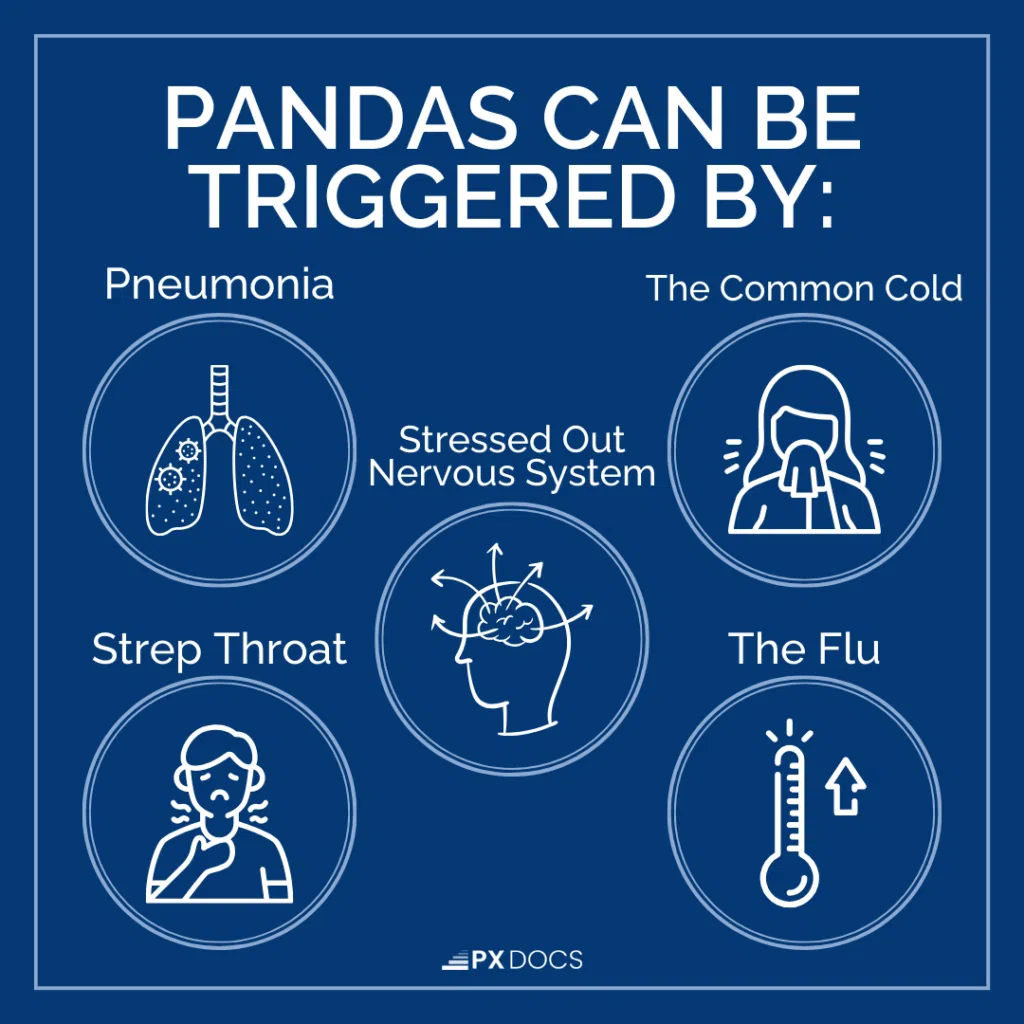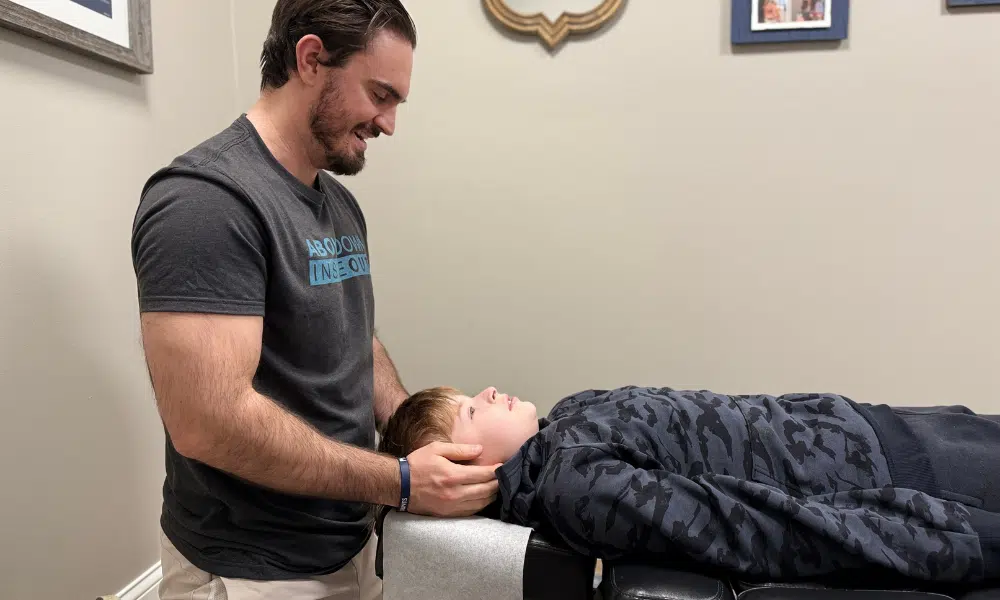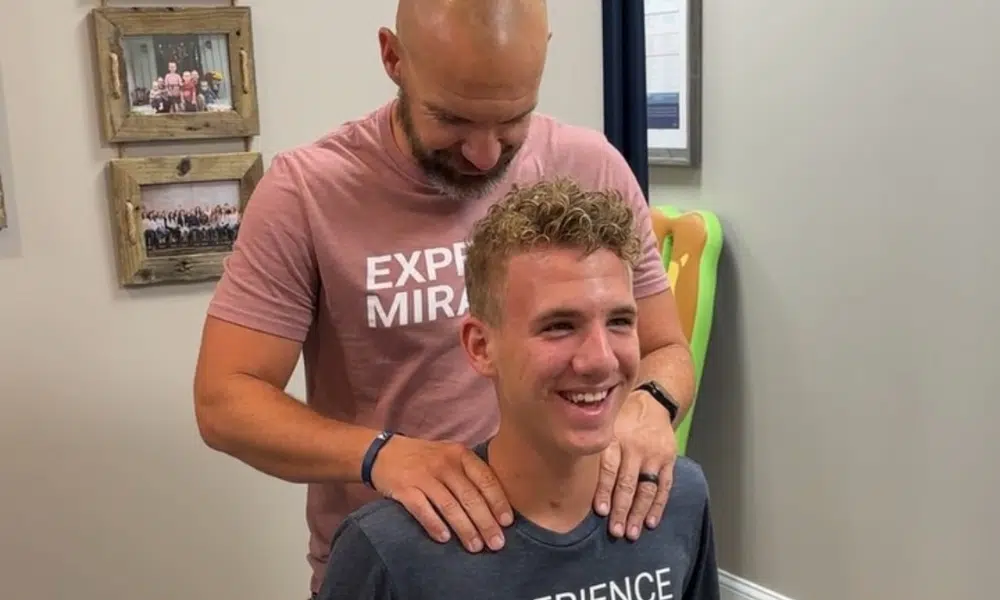PANDAS DISORDER DEFINED:
PANDAS disorder, an acronym for Pediatric Autoimmune Neuropsychiatric Disorders Associated with Streptococcal Infections, is a rare but impactful condition that typically emerges in childhood following a strep throat infection. At PX Docs, we understand the complexities of PANDAS, which manifests through a sudden onset of obsessive-compulsive behaviors, tics, and noticeable changes in mood and behavior. Our approach to PANDAS is rooted in compassion and the latest insights, ensuring that each child receives personalized, holistic care. We believe in empowering families with knowledge and support, guiding them through the journey of understanding and managing this unique and challenging disorder.
What are the Signs and Symptoms of PANDAS Disorder?
Since the autonomic and central nervous system control every component of a child’s health, from their physical body (muscles, joints, etc.) to their mental, behavioral, and emotional well-being… the signs and symptoms of PANDAS can be far-reaching and usually a child, unfortunately, experiences many of them at the same time.
In conjunction with the strep infection, tics, and generalized anxiety a child experiencing PANDAS Disorder may also struggle with one or more of the following:
- Symptoms of ADHD
- Ex. such as hyperactivity, inattention, fidgeting, uncontrolled jerky movements
- Separation Anxiety
- Ex. child is “clingy” and has difficulty separating from his or her caregivers; for example, the child may not want to be in a different room in the house from his or her parents
- Mood + Behavior changes
- Ex. such as irritability, sadness, tantrums, or emotional lability (i.e., tendency to laugh or cry unexpectedly at what might seem the wrong moment)
- Sleep Disorders
- Ex. difficulty falling asleep, staying asleep, and bed wetting (often during the day as well)
- Sensory Integration Challenges
- Ex. sensitivity to light, hearing things that aren’t there
- Altered Motor Tone + Coordination
- Clumsy, tripping often, poor coordination, changes in handwriting
- Joint + Flexibility Problems
- Joint pain, stiffness, achiness, and muscle spasms
- Decreased Appetite + Energy
- Tired, lethargic, unable to eat much or try new foods
Because PANDAS Disorder “crosses over” and “spills over” to the nervous system in such a big way, really the list of possible signs and symptoms that go with it is nearly endless. The related neurological challenges we’re discussing here are officially called subluxation and dysautonomia, and we’ll discuss them in detail in the following sections of this article.
How Is PANDAS Disorder Diagnosed?
Conventional medical doctors are not entirely up to speed on the labs that can be used to help identify PANDAS and PANS-related conditions, but integrative and functional medicine practitioners can be very helpful in first tracking it down and then helping families with environmental and diet changes, supplements and herbal support, and so much more.
To learn more about a natural, integrative approach, you can check out these articles from Dr. Josh Axe on autoimmune challenges and strep infections. Additionally, this Healthline article breaks down some natural approaches and research quite well.
The most common way PANDAS Disorder is diagnosed is through a grouping of the following symptoms and clinical presentations:
- Presence of OCD, a tic disorder, or both
- Pediatric onset of symptoms (age 3 to puberty)
- Association with group A Beta-hemolytic strep infection, such as a positive throat culture for strep or a history of scarlet fever
- Association with neurological abnormalities, such as physical hyperactivity or unusual, jerky movements that are not in the child’s control
- Very abrupt onset or worsening of symptoms
What Causes PANDAS Disorder?
The vast majority of medical professionals now think that PANDAS is most certainly an autoimmune challenge, where the antibodies that the body makes don’t just attack the strep infection but start to cause levels of inflammation and damage that then irritate the central and autonomic nervous system as well. If the strep cells ‘mimic’ the healthy neural tissue, then the immune system also attacks those, leading to some of the damage and the disorder.
But like all of the articles here on our PXDocs.com site, we always like to dig at least one layer deeper and ask the tough questions.
In the case of PANDAS Disorder, the tough question would be – what’s causing the autoimmune component? Why do some kids have immune systems that can easily distinguish between strep cells and healthy neural cells, and others can’t? What’s causing the confusion in PANDAS kids?
To really sort out the answers to the most underlying and important questions, we need to strongly consider another clinical correlation we see in nearly every PANDAS disorder case we see coming into our practices (and the same goes for Autism, ADHD, Anxiety, Sensory, Seizures, and more).
As Pediatric Chiropractors, we are trained not to just take a case history as a routine procedure that fulfills our paperwork requirements. Instead, we take a vastly different approach than a standard pediatrician or medical doctor, and we listen very intently for any possible “clues” and correlations to what could really be the true root cause of the child’s PANDAS disorder and related conditions.
Because the multitude of symptoms a child with PANDAS experiences “cross over” into nearly every major system of the body (respiratory, immune, gut, musculoskeletal, brain, etc.) can only mean one thing – the nervous system is intricately involved.
The nervous system is the one singular system that connects, controls, modulates, and integrates all other systems + cells of the body. So simply put, if the nervous system is out of balance and struggling with what’s called dysautonomia… then every other system of the body will be out of balance and dysfunctional as well.
Here are the four (4) major systems of the body negatively affected by dysautonomia:
- Respiratory System – rapid, shallow breathing with lowered oxygenation
- Immune System – increased inflammation and autoimmune responses, increased mucus production and decreased motility and drainage of the respiratory + lymphatic system (poor detoxification)
- Motor (Muscular) System – increased neuromuscular tone, tension and spasm, motor tics, stiffness, pain, and poor balance + coordination
- Mental + Emotional Regulation – increases in anxiety and tension, as well as brain fog, fatigue, trouble concentrating and regulating mood, OCD, etc.

The Perfect Storm – Birth Trauma, Antibiotics, and More
After taking hundreds and hundreds of case histories, training thousands of other PX Docs to do the same, and doing hours upon hours of research, the two things that continually stand out in children struggling with PANDAS Disorder and neurological challenges are:
- Birth Intervention + Birth Trauma that led to difficulties breastfeeding, colic, constipation, and motor development challenges
- Frequent Respiratory + Immune Challenges early in life that led to frequent antibiotics and steroids medication use
The specific types of birth intervention + birth trauma we see correlated with PANDAS Disorder in our clinics are vacuum extraction births and c-sections.
The subluxation process and patterns those specific birth interventions frequently create are ones that negatively affect the drainage of mucus and secretions in the throat, airway, and lungs, which then lead to a greater chance of the opportunistic streptococcal (strep) cells staying in the area, replicating, and causing a “spill over” of inflammation + irritation in that area of the brainstem and neurospinal system, which just so happen to be highly involved in autonomic nervous system regulation via the vagus nerve.
We want to go deep yet keep this simple, so here is the Perfect Storm “batting order” specifically for PANDAS disorder correlations listed out in order:
- Physical birth trauma to the upper neck and brainstem area, resulting in subluxation
- Subluxation leads to excessive sympathetic nervous system response and lowered parasympathetic or vagal nerve tone… which is known as dysautonomia
- Dysautonomia then alters and disrupts the function of the respiratory, immune, digestive, and motor systems and allows the physiological mechanisms of things like PANDAS disorder to set in
And finally, the Perfect Storm “vicious cycle” continues until the “root root” elements of the nervous system dysfunction are found and taken care of.
This is why so many patients who come to us have already exhausted all of the traditional medical options, such as antibiotics, steroids, and continuous medications, and still need all sorts of help getting the body to heal and rebuild naturally on its own.
If the subluxations and dysautonomia remain present, the child is far more susceptible to every new cold, respiratory infection, seasonal or weather change, and stressful time in life. That is one of the biggest struggles for families dealing with PANDAS disorder, knowing that all sorts of very regular and ordinary life situations can trigger the symptoms to come back with a vengeance seemingly overnight.
What’s the Difference Between PANS and PANDAS Disorder?
When it’s clear that a child’s symptoms are linked to a strep infection, it’s called PANDAS. PANS (Pediatric Acute-onset Neuropsychiatric Syndrome), in turn, can be linked to a severe onset of OCD and other neurological symptoms from another infection. These may include the flu, chickenpox, mycoplasma, and Lyme disease.
How Long Does PANDAS Disorder Last?
Once again, this is one of the most frustrating aspects of PANDAS disorder for kids and their parents. While the acute onset of symptoms typically lasts a few days, weeks, or months… they can be triggered repeatedly by common and ordinary things like a new cold, seasonal and weather changes, and so forth.
Therefore even when a child is doing well, it can cause a buildup of continual worry and anxiety in both the child and parent as to when it will happen again.
As a result, many children with a PANDAS diagnosis end up struggling with things such as High Functioning Anxiety and Sensory Integration Disorder over time. Their case needs to be managed not just acutely but with a consistent, ongoing care and support model as well.
Treatment for PANDAS Disorder
Because of the severity and complexity of PANDAS disorder, it’s always best to have a team of practitioners working in collaboration to get the child better and through this storm.
An excellent integrative pediatrician can be there to provide the antibiotics or steroids medications at times when the infections are really ramped up, and such an approach is needed, or ideally, can work in coordination with your neurologically-focused pediatric chiropractor and other specialists to take care of things without medications as much as possible.
The medications traditionally used are, of course, antibiotics and anti-inflammatories, the integrative approach centers on plasma exchange and immunoglobulin IVIG with heavy doses of immune-boosting supplements and materials. And lastly, cognitive behavioral therapy is also a resource often recommended.
Then, to ensure you can address the “root root” challenges at hand, having a neurologically-focused pediatric chiropractor on the team is essential to optimal and complete healing. Learn more about how our approach works below, as well as learn about a few of the components of our care approach here on the blog.
The real key to understanding the neurologically-focused chiropractic approach (PX Docs) to PANDAS and really all disorders is knowing that we are NOT looking to treat or cure the disorder or making any claims as such. We simply work to restore balance and function to the nervous system and let the body’s natural healing mechanisms kick in, keep going, and get the job done.
How to Prevent PANDAS Disorder
Overall the best approach to preventing PANDAS for children is the exact same thing it is to build and boost childhood health overall. Check out this article for in-depth ways to naturally care for PANDAS. A consistent health plan with foundations on neurological and immune health, good sleep, staying active, creative play, clean eating, home environment, and so forth is essential.
This 7 Steps to Raising Healthy Kids Naturally Guide you can download right here from the site will be exactly what you’re looking for!
And then what we tell our PANDAS and Perfect Storm parents and families is that if your child has battled these chronic health issues in the past, as you keep moving forward, you want to take each good thing on that list and essentially “double down” on it. Which could end up looking like this:
- Getting adjusted 2-3x per week instead of just 1x per week
- Sticking to 1 sport or extracurricular activity for a season instead of 2-3
- Prioritizing an extra 1-2 hours of sleep and rest
- Adding in extra immune-boosting supplements (or upping dosages), herbs, and vitamins
How Can I Find a Specialist for PANDAS Disorder?
While none of our PX Docs likely has a full clinic dedicated just to PANDAS Disorder, each and every doctor in our network is an absolute expert in neurological function and health and is trained to assess and care for subluxation and dysautonomia in full.
If you have gone down the traditional medical, integrative, and nutritional approach with your child’s PANDAS disorder and feel like there still is a missing piece and component, it’s likely chiropractic.
Head over to our incredible PX Docs directory page and book your consultation and examination appointments today!






